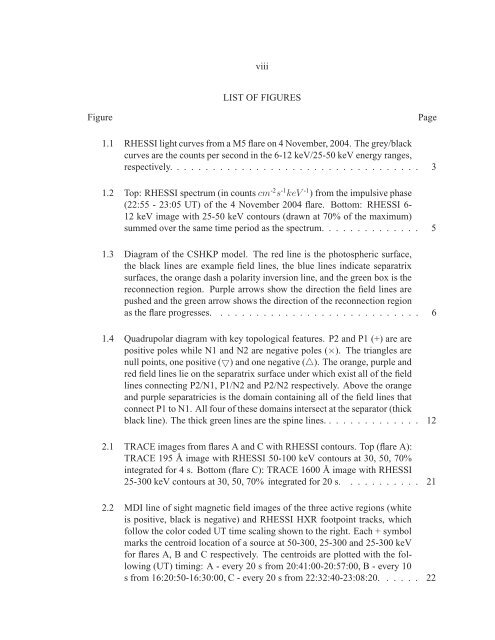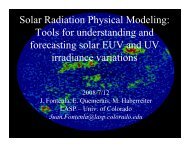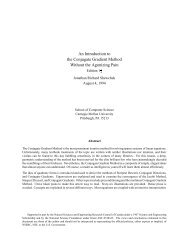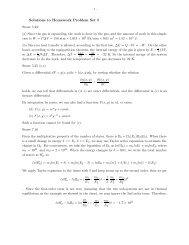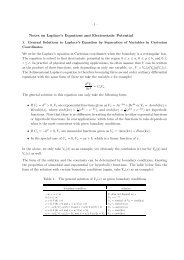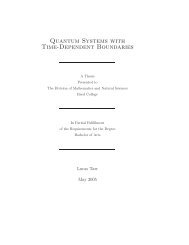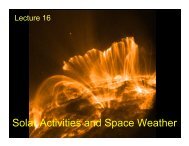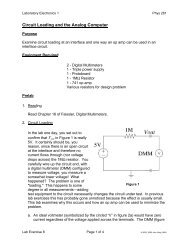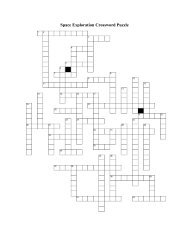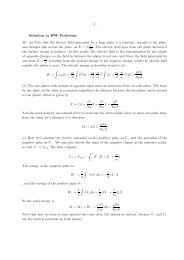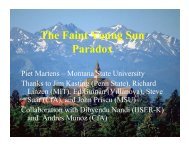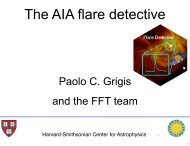The Topology of Magnetic Reconnection in Solar Flares
The Topology of Magnetic Reconnection in Solar Flares
The Topology of Magnetic Reconnection in Solar Flares
Create successful ePaper yourself
Turn your PDF publications into a flip-book with our unique Google optimized e-Paper software.
viiiLIST OF FIGURESFigurePage1.1 RHESSI light curves from a M5 flare on 4 November, 2004. <strong>The</strong> grey/blackcurves are the counts per second <strong>in</strong> the 6-12 keV/25-50 keV energy ranges,respectively. . . . . . . . . . . . . . . . . . . . . . . . . . . . . . . . . . . 31.2 Top: RHESSI spectrum (<strong>in</strong> counts cm -2 s -1 keV -1 ) from the impulsive phase(22:55 - 23:05 UT) <strong>of</strong> the 4 November 2004 flare. Bottom: RHESSI 6-12 keV image with 25-50 keV contours (drawn at 70% <strong>of</strong> the maximum)summed over the same time period as the spectrum. . . . . . . . . . . . . . 51.3 Diagram <strong>of</strong> the CSHKP model. <strong>The</strong> red l<strong>in</strong>e is the photospheric surface,the black l<strong>in</strong>es are example field l<strong>in</strong>es, the blue l<strong>in</strong>es <strong>in</strong>dicate separatrixsurfaces, the orange dash a polarity <strong>in</strong>version l<strong>in</strong>e, and the green box is thereconnection region. Purple arrows show the direction the field l<strong>in</strong>es arepushed and the green arrow shows the direction <strong>of</strong> the reconnection regionas the flare progresses. . . . . . . . . . . . . . . . . . . . . . . . . . . . . 61.4 Quadrupolar diagram with key topological features. P2 and P1 (+) are arepositive poles while N1 and N2 are negative poles (×). <strong>The</strong> triangles arenull po<strong>in</strong>ts, one positive (▽) and one negative (△). <strong>The</strong> orange, purple andred field l<strong>in</strong>es lie on the separatrix surface under which exist all <strong>of</strong> the fieldl<strong>in</strong>es connect<strong>in</strong>g P2/N1, P1/N2 and P2/N2 respectively. Above the orangeand purple separatricies is the doma<strong>in</strong> conta<strong>in</strong><strong>in</strong>g all <strong>of</strong> the field l<strong>in</strong>es thatconnect P1 to N1. All four <strong>of</strong> these doma<strong>in</strong>s <strong>in</strong>tersect at the separator (thickblack l<strong>in</strong>e). <strong>The</strong> thick green l<strong>in</strong>es are the sp<strong>in</strong>e l<strong>in</strong>es. . . . . . . . . . . . . . 122.1 TRACE images from flares A and C with RHESSI contours. Top (flare A):TRACE 195 Å image with RHESSI 50-100 keV contours at 30, 50, 70%<strong>in</strong>tegrated for 4 s. Bottom (flare C): TRACE 1600 Å image with RHESSI25-300 keV contours at 30, 50, 70% <strong>in</strong>tegrated for 20 s. . . . . . . . . . . 212.2 MDI l<strong>in</strong>e <strong>of</strong> sight magnetic field images <strong>of</strong> the three active regions (whiteis positive, black is negative) and RHESSI HXR footpo<strong>in</strong>t tracks, whichfollow the color coded UT time scal<strong>in</strong>g shown to the right. Each + symbolmarks the centroid location <strong>of</strong> a source at 50-300, 25-300 and 25-300 keVfor flares A, B and C respectively. <strong>The</strong> centroids are plotted with the follow<strong>in</strong>g(UT) tim<strong>in</strong>g: A - every 20 s from 20:41:00-20:57:00, B - every 10s from 16:20:50-16:30:00, C - every 20 s from 22:32:40-23:08:20. . . . . . 22


